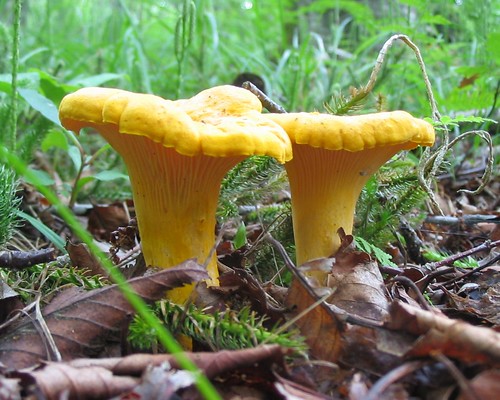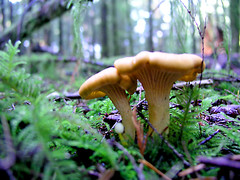 Chantarelles are a choice culinary mushroom prized by chefs around the world. And they grow in Washington, DC.
Chantarelles are a choice culinary mushroom prized by chefs around the world. And they grow in Washington, DC.The most common chantarelle species in our area, Cantharellus cibarius, generally comes up in July; we've already found several this year. They are golden yellow to yellow-orange (but not pumpkin orange). The gills on the underside of the cap are very distinctive because they continue down the stem, and are not very deep -- it's almost like the mushroom has wrinkles, rather than the gills you'd see on a typical gilled mushroom. The smell is also distinctive -- sweet and fruity, like apricots (some guidebooks also suggest rose and pumpkin).
If you're not already a mushroomer, the safest and most productive way to look for wild mushrooms is to go with people who already know what they're doing. Luckily, we have in this area the Mycological Association of Washington, which organizes forays led by people who have an encyclopedic knowledge of our local fungi. They'll generally schedule hunting expeditions in areas where they've had luck in the past, and will identify any mushrooms found on the hike. Even more luckily, there's a foray this Saturday at Lake Bernard Frank.
If you prefer to go on your own, please, please, please get ahold of a couple of mushroom id books and carefully check anything you pick before you eat it. Also, wild mushrooms should always be cooked before you eat them, and never eat anything that looks bug-ridden or rotten, no matter how tempting. For example, chanterelles often have very buggy stems -- cut that part out and just eat the healthy parts. Many cases of "mushroom" poisoning are actually attributable to eating mushrooms that are past their prime.
 In the wild: We have seen chantarelles in both Rock Creek Park and Greenbelt Park, sometimes growing right in a trail. (Of course, we should remind you, it is illegal to remove mushrooms from a National Park.) If you find a good spot, check back every year -- the mycelium (something like fungus roots) stay in the same place and produce new fruits (the mushrooms) every year.
In the wild: We have seen chantarelles in both Rock Creek Park and Greenbelt Park, sometimes growing right in a trail. (Of course, we should remind you, it is illegal to remove mushrooms from a National Park.) If you find a good spot, check back every year -- the mycelium (something like fungus roots) stay in the same place and produce new fruits (the mushrooms) every year.In your yard: Not unless you live in undisturbed woods and are really lucky. No one has figured out how to cultivate chantarelles yet. That's what makes it so special to find them in the wild!
Have you found any chantarelles yet this year? Have any good recipes? Let us know -- even if you're not willing to tell us your spot!


